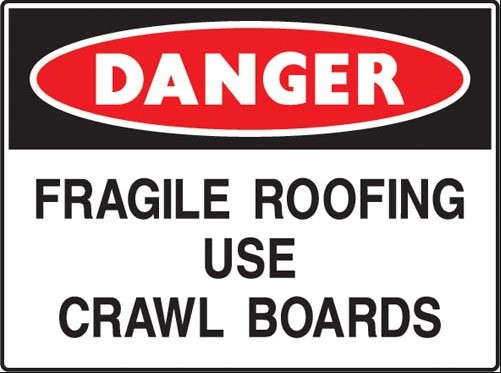Fragile roofing materials may fracture without warning.
Fractures can occur so rapidly that a worker could easily fall through the roof, suffering serious or even fatal injuries.
All roofs should be treated as fragile until a competent person has confirmed they are not.
No sheeted roof should be relied on to bear a person’s weight. This includes the roof ridge and purlins. Roofs are likely to be fragile if they are made with:
- asbestos roofing sheets
- polycarbonate or plastic commonly used in skylights
- roof lights, particularly those in the roof plane that can be difficult to see in certain light conditions or when hidden by paint
- fibre cement sheets
- liner panels on built-up sheeted roofs
- metal sheets and fasteners where corroded
- glass, including wired glass
- chipboard or similar material where rotted
- wood slabs, slates and tiles.
Risk control measures
Before working on any roof area or using the roof as a means of access (eg for construction, repair, maintenance, demolition or inspection), it is essential to identify all potential hazards and conduct a risk assessment.
This risk assessment should include:
- inspection of the perimeter walls for warning notices
- review of any asbestos register (where applicable)
- visual inspection of the roof to determine the presence, condition and extent of fragile materials and supports
- the distribution of the load
- existence and condition of safety mesh
- risks of a person falling (eg void or unprotected edge)
- accessibility of access and egress points
- any other factors that may affect the health and safety of workers.
A plan to safely carry out the work should then be developed (eg safe work procedure or safe work method statements where high risk construction work activities have been identified).
The risk assessment may identify the need to use:
- an elevating work platform so workers can avoid standing on the roof itself
- barriers such as guard rails or covers that are secured and labelled with a warning
- guard rails fitted to all work and access staging or platforms
- walkways or crawl boards of a suitable size and strength
- staging on the roof surface to spread the loads
- safety mesh secured under fragile roofing or skylights
- a safety harness and fall arrest equipment such as static lines, running lines or inertia reels, along with appropriate training and supervision
- suitable footwear that controls the risk of slipping and other site hazards.
Fall arrest
Fall arrest equipment needs to be installed by a licensed scaffolder or rigger. Wearing harnesses creates a trip hazard, so workers must take extra care with them. Training should include how to rescue someone who falls while using a fall arrest system.
Safety mesh
If safety mesh is used, ensure it:
- conforms to AS/NZS 4389: Roof safety mesh
- is installed by a competent person in a safe manner and in accordance with the manufacturer’s instructions
- secured immediately above or below a skylight
- is covered by the roof cladding as soon as reasonably practicable after it has been installed
- has its integrity inspected by a competent person prior to roof maintenance or removal.
If you are unsure about whether safety mesh is fitted, consider the roof as unmeshed and dangerous.
Fragile roof signage
Fragile roof signage must be fixed to the walls of buildings where access can be made to fragile roofs.
Signs should be made from sheet metal or other approved material that is at least 600mm by 450mm in size with wording and layout similar to that shown below.

Refer to Australian Standard AS1319-1994, in Section 2.3.4 and Appendix C and Appendix D: Use of colour for the marking of physical hazards and the identification of certain equipment in industry.
Legal duties
Under the Work Health and Safety Act 2012 (SA), a person with management or control of a workplace cannot transfer their health and safety obligations by engaging a contractor to undertake work on their roof.
Outsourcing work does not remove their obligations to ensure the health and safety of the contractor, their employees, or other sub-contractors engaged.
Effectively a person with management or control of a workplace has the same responsibilities to contractors as they have to their own employees.
Effective management of contractor’s health and safety risks, will reduce the risk of injuries occurring, minimise exposure to litigation and improve completing projects on time and within budget.
Read further on engaging contractors.
Compliance focus
According to ReturnToWork SA, 754 claims were made in 2019 financial year, for injuries sustained from falls from height across all industries.
The construction industry accounts for nearly 19% of these claims.
Construction continues to be one of the most hazardous industries, exposing workers to a variety of hazards and risks, resulting in unacceptably high levels of injuries and fatalities.
In response to this, SafeWork SA’s inspectors will be undertaking compliance audits in 2020 on Safe Work Method Statement (SWMS) for high risk construction work (HRCW).
The WHS Regulations prescribe 18 specific activities as HRCW, due to the significant potential for serious harm that is often associated with those activities.
One of these prescribed activities is work that involves a risk of a person falling more than 3 metres, for example, working on a roof.
SWMS are a key strategy relied upon to reduce the number of injuries and fatalities within the construction industry.
Further information
- Managing the risk of falls at workplaces – Code of Practice
- Safe Work Method Statements for high risk construction work
- AS 1562.3: Design and installation of sheet roof and wall cladding – Plastic
- AS 1318: Use of colour for the marking of physical hazards and the identification of certain equipment in industry
- AS/NZS 4389: Roof safety mesh
- Safety alert – Managing the risk of falls from fragile roofing




